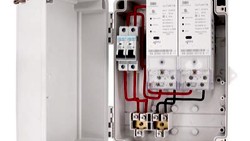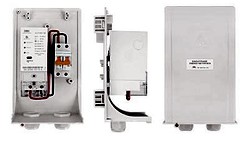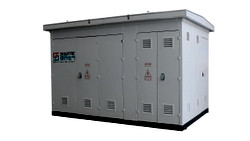Electricity meters are one of the most important components of a power grid. These devices measure the amount of electricity consumed by a household, commercial building, or industrial plant, and help in billing the customers accordingly. Traditionally, electricity meters have been simple devices that measure the amount of electricity consumed and display it on a mechanical or digital display. However, with the advent of new technologies and the need for better management of the power grid, smart meters have emerged as a popular alternative.

“Smart” is an overused term these days, but when it comes to energy meters, it's more than just a buzzword. So, when can an electrical energy meter be considered to be smart? In this article, we will explore the characteristics of a smart meter and what sets it apart from a traditional meter.
Communication
Smart meters, also known as part of advanced metering infrastructure (AMI), are electronic devices that are capable of measuring and transmitting electricity consumption data at regular intervals. Unlike traditional meters, smart meters do not require manual reading or physical access to the device. Instead, they use communication technologies such as cellular networks, radio frequency (RF) or power line communication (PLC) to transmit data to the utility company.
Consumption Patterns
One of the main features of a smart meter is its ability to provide detailed information about energy consumption patterns. Smart meters can record and transmit data about the amount of electricity consumed at different times of the day, week, or month. This data can be used by the utility company to analyse consumer behaviour and develop new pricing models that incentivize customers to consume electricity during off-peak hours. This helps to balance the load on the power grid and reduce the need for expensive upgrades.
Outage- and Tamper Detection
Smart meters also have the ability to detect power outages and other issues in the power grid. They can instantly alert the utility company when an outage occurs and provide information about the location and extent of the outage. This helps the utility company to quickly dispatch repair crews and restore power to customers. Additionally, smart meters can detect tampering and other forms of fraud, which helps to prevent revenue losses for the utility company.
Two-way Data Exchange
Another important feature of smart meters is their ability to support two-way communication. This means that the utility company can send information back to the smart meter, such as pricing information, demand response signals, or outage updates. This enables customers to make more informed decisions about their energy consumption and respond to price signals in real-time. For example, a customer can choose to reduce their electricity consumption during times of high demand when prices are higher, and increase consumption during off-peak hours when prices are lower.
Remote Dis-/Reconnection
Smart meters also have the ability to support remote disconnect and reconnect services. This means that the utility company can remotely disconnect or reconnect a customer's electricity supply, without the need for a technician to physically visit the property. This is particularly useful for customers who are moving house or who are having trouble paying their bills. By remotely disconnecting the electricity supply, the utility company can ensure that customers are not using electricity that they are not paying for, and avoid the need for costly disconnection and reconnection services.
Load Limiting
Smart meters can be used for load limiting. Load limiting is the process of reducing the amount of electricity that is available to a customer or group of customers. This can be done for a number of reasons, such as to prevent overloading the grid, load shedding or to conserve energy during peak demand periods.
Bidirectional Metering
Advanced smart meters can also work bidirectional for integration of renewables, like solar or wind. Bidirectional smart meters can measure both energy flow into (Import) and out of (Export) a home or business. This information can be used to help customers manage their energy use and to integrate renewable energy sources into the grid.
For example, a customer with a solar panel system can use a bidirectional smart meter to track the amount of energy their solar panels are generating. This information can be used to help the customer make informed decisions about how to use their solar energy, such as by storing it in a battery or selling it back to the grid.
Bidirectional smart meters can also be used to help utilities integrate renewable energy sources into the grid. For example, a utility company can use bidirectional smart meters to track the amount of energy being generated by distributed energy resources, such as solar panels and battery storage systems. This information can be used to help the utility company manage the grid and to ensure that it is able to meet the needs of its customers.
Takeaway
An electrical energy meter can be considered smart if it has the ability to provide detailed information about energy consumption patterns, detect power outages and fraud, support two-way communication, and offer remote disconnect and reconnect services. Smart meters are an important tool for managing the power grid and ensuring that electricity is delivered reliably and efficiently to customers.
Our team of experts can answer your questions and provide you with the information you need to make the best decision for your business. Contact us today to learn more.
Editor's note: This article was originally published in May 2023 and has been updated for comprehensiveness.





Bueno noches,cuando las distribuidoras de servicios públicos incorporan la tecnología Wi-SUN reemplazando los módulos 3G de colectores de datos por módulos Wi-SUN,no queda más uso para los módulos 3G o aún se pueden emplear y qué ejemplos me darían?.
Buenas noches Armando, te respondo según nuestras experiencias en el mercado. Los medidores inteligentes con comunicación se implementan mayoritariamente módulos de comunicación G3-PLC. En china se pueden encontrar mucha oferta este tipo de módulos, debido a la economía de escala el coste de fabricación a disminuido considerablemente para ser las tecnología predeterminada para la eficiencia de transmisión de datos. En cuanto el Wi-sun a pesar que la comunicación es más rápida y mayor banda ancha que muchos módulos de RF y disminuye el coste a largo plazo en comparación el coste mensuales de datos de celular. Pero todavía no es un sustitutivo de medio de comunicación porque los componentes electrónicos y el procesador de comunicación tiene muy alto coste y muy poca oferta. Y cada país o región tiene un frecuencia de comunicación diferente que se debe modificar el software del módulo de Wi-sun. Actualmente la fabricación de módulos de Wi-sun no es justificable para una solución AMI para usuarios residenciales o comerciales hasta que no disminuyan los costes de los componentes electrónicos. Respecto al 3G no está en desuso ni tampoco se están reemplazando, sino se usa para usuarios importantes o subestaciones que necesitas monitorear la información de datos a tiempo a una mayor frecuencia de exportación.